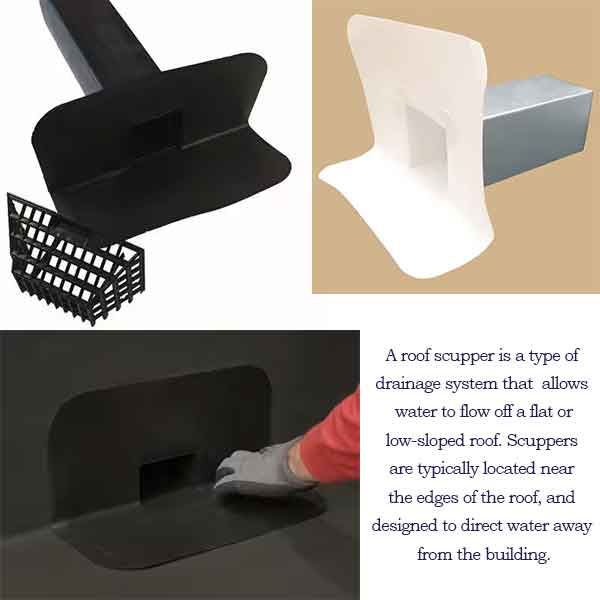What is a Roof Scupper?
A roof scupper is a type of drainage system that allows water to flow off a flat or low-sloped roof. Scuppers are typically located near the edges of the roof, and designed to direct water away from the building. Roof scuppers prevent water from pooling on the roof and causing costly damage to your roof membrane. They can be made of metal and are often incorporated into the design of a building’s façade or parapet walls. They often drain into downspouts to make sure water drains away from the building. In addition to their function as a drainage system, roof scuppers can also serve as a decorative element in a building’s design.
Benefits of a Roof Scupper
A roof scupper is an important part of any roofing system and provides many benefits. Firstly, it is a simple, affordable, and effective way to drain water off your roof. Secondly, roof scuppers prevent water ponding that causes damage to your roof membrane. Especially when paired with tapered insulation and roof crickets. Thirdly, properly placed scuppers provide great drainage on large commercial buildings where lots of rain can need to be drained very quickly. They also provide a great emergency backup for a primary drain system if it gets clogged. Lastly, you don’t have to run drainage pipes into your building with a scupper system. Running drain pipes inside raises the cost of installation and increases the chances of indoor leaks and water damage.
What Kind of Maintenance do Scuppers Need?
Like any type of drainage system, scuppers require regular maintenance to ensure that they are functioning properly. Some common maintenance tasks that may be necessary for scuppers include:
Cleaning: Scuppers, like roof drains, can become clogged with debris such as leaves, twigs, and other materials. The debris prevents water from flowing through them properly and allows water to pool on the roof. It is important to regularly clean all types of roof drains to remove blockages and ensure effective roof drainage. Cleaning the metal can also prevent rusty scuppers that will deteriorate and need to be replaced.
Inspecting for Damage: Scuppers can become damaged over time due to weather, wear and tear, or other factors. It is important to periodically inspect them for signs of damage, such as cracks, holes, and/or rust, and repair or replace them as needed.
Checking for Proper Drainage: Scuppers should be checked regularly to ensure that they are directing water away from the building as intended. If water is not flowing properly, it could be a sign that there is a problem with the drainage system that needs to be addressed. Damp spots near the base of the building can be sign of improper roof drainage.
Maintaining the Surrounding Area: It is important to maintain the area around scuppers to ensure that they are not obstructed by debris or other materials that may prevent water from flowing to the scuppers and away from the building. This can include regularly cleaning the roof and removing any debris.
